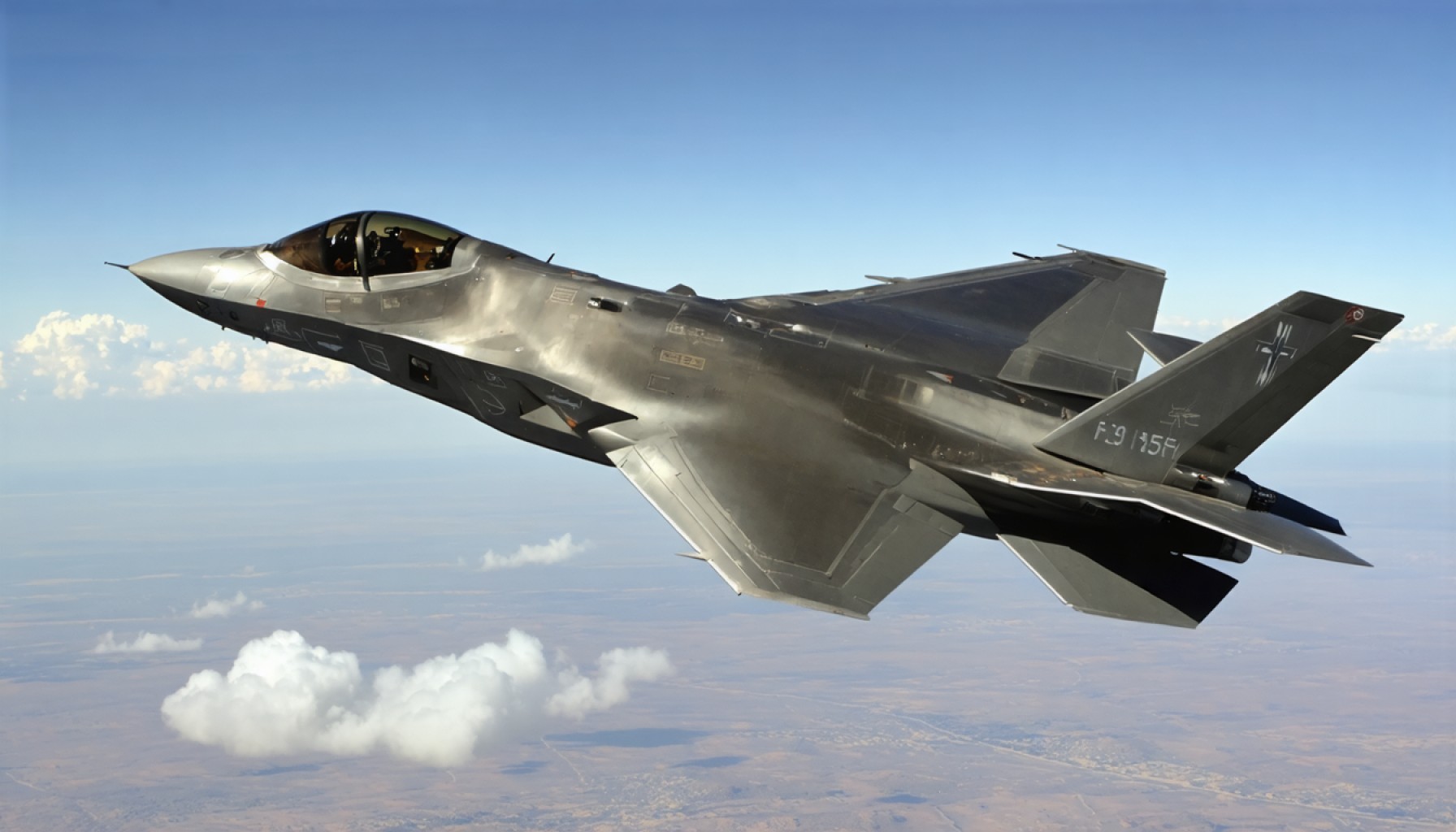- The Israeli Air Force identified a safety concern with its F-35 “Adir” fighter jets, pausing flights for thorough inspections.
- The inspections led to the replacement of a faulty component, ensuring the jets were ready for operation without compromise.
- Israel’s strategic collaboration with the United States continues to grow, with plans to expand its F-35 fleet.
- The acquisition of 25 additional jets highlights Israel’s commitment to advancing its air combat capabilities.
- These F-35s offer superior stealth and intelligence, providing critical tactical advantages in regional defense.
- Despite challenges, the Israeli Air Force’s response demonstrated resilience and adaptability in safeguarding national security.
The Israeli Air Force’s sophisticated F-35 fighter jet, nicknamed the “Adir,” recently faced a hidden hiccup that brought unexpected turbulence to its seamless reputation. News broke that a potential safety issue loomed within these cutting-edge machines, drawing swift attention from both Israeli authorities and its US manufacturer.
Upon receiving whispers of a questionable component, the air force reacted with precision typically reserved for much larger crises. Flights of these newly acquired stealth fighters were paused, allowing meticulous inspections to unfold. It was an act of caution that held the world’s gaze, as the Adir, a dominant force in Israel’s aerial arsenal, is famously known for its stealth and intelligence capabilities.
Inside dimly-lit hangars, engineers and specialists, eyes intent and gloved hands steady, conducted a symphony of tests. Their objective was clear: isolate and resolve the unease within these aerial marvels. Ultimately, this precise dance of technical expertise led to the replacement of a singular errant component. The skies were reassured once more, and the Adirs took flight into their role as guardians of Israel’s defense perimeter, unimpeded and confident.
Beyond the immediate shadows of this component caution lies a broader story—a narrative woven with strategy and advanced warfare. Last year, Israel cast its gaze forward, signing a deal with the United States to expand its F-35 fleet. This procurement not only underscores a deep alliance across continents but also signals a sweeping stride into the future of air combat—securing 25 new jets, incrementally bolstering the squadron year by year.
Set against the backdrop of regional tensions, the Adir jets embody a tactical advantage. Imagine these gliding titans, equipped with sophisticated stealth capabilities, burning through the skies undetected, watchful, and ready. Their arrival brings more than mere numbers; it heralds an integration of intelligence and dominance, a testament to Israel’s relentless pursuit of security.
In the face of unforeseen challenges, the Israeli Air Force demonstrated resilience and adaptability, reinforcing the country’s defense layer by layer. At the core of this saga lies a reminder: progress, while occasionally stumbling upon hurdles, bends but does not break. The skies remain watchful, and aircraft rise anew, more fortified than ever before.
The Hidden Challenges Behind Israel’s F-35 Air Fleet: What You Need to Know
Inside the F-35’s Recent Turbulence
The F-35 fighter jet, known as “Adir” in the Israeli Air Force, recently faced a minor but significant challenge. A potential safety issue with an undisclosed component prompted the suspension of flights, drawing attention from both Israeli authorities and its U.S. manufacturers. This incident, while swiftly managed, provides valuable insights into the operational challenges and strategic importance of the F-35 program.
What Sets the Adir Apart?
The Israeli version of the F-35, nicknamed Adir, is renowned for its cutting-edge stealth capabilities, advanced electronic warfare systems, and superior intelligence-gathering techniques. These features make it a cornerstone of Israel’s air defense strategy, allowing it to perform precision strikes while remaining largely undetected by enemy radar systems.
How the Issue Was Managed
Upon identifying a potential component flaw, Israeli Air Force engineers conducted thorough inspections and tests within the controlled environment of their hangars. This crisis management exemplifies the Israeli Air Force’s expertise in handling technical glitches, ensuring the aircraft returned to operational status without compromising safety.
Israel’s Expanding F-35 Fleet: A Strategic Move
Last year, Israel signed a landmark agreement with the United States to procure 25 additional F-35 jets, further solidifying its air superiority. This acquisition highlights the ongoing strategic alliance between the two countries, enhancing Israel’s defensive and offensive capabilities.
Real-World Use Cases
– Stealth Operations: The F-35’s ability to evade radar detection makes it ideal for sensitive reconnaissance missions and surprise air assaults.
– Electronic Warfare: The Adir can disrupt enemy communications and radar systems, providing an advantage in electronic warfare.
– Integration with Allied Forces: The F-35’s compatibility with NATO systems allows seamless operations with allied forces, a crucial factor in joint military exercises and operations.
Features and Specifications
– Stealth Technology: Advanced coatings and body design reduce radar cross-sections.
– Avionics: State-of-the-art radar and electronic systems for superior situational awareness.
– Weapons Systems: Capability to carry a diverse array of weapons, including both Israeli and U.S.-made armaments.
Looking Ahead: Industry Trends and Predictions
The F-35 program continues to evolve, with ongoing investments in software updates and hardware improvements to maintain its edge in modern warfare. Market forecasts predict an increased emphasis on AI and machine learning to enhance autonomous capabilities and decision-making processes in real-time combat scenarios.
Possible Controversies and Limitations
While the F-35 remains a formidable asset, it has faced criticism over high production costs and maintenance expenses. Furthermore, the complexity of its systems necessitates extensive pilot training.
Recommendations for Defense Enthusiasts
– Stay updated on developments in F-35 technology and tactics via defense community forums and official military releases.
– Engage with Lockheed Martin, the manufacturer, for the latest insights into the F-35’s technological advancements.
Quick Tips
– For Aviation Enthusiasts: Keeping abreast of geopolitical shifts can provide context to the military strategies of countries like Israel.
– For Defense Analysts: Investigate how emerging technologies like AI and cybersecurity are being integrated into the F-35 platform.
In conclusion, the recent issues faced by Israel’s F-35 “Adir” jets serve as a testament to the intricate balance between technological advancement and military preparedness. Despite occasional setbacks, the future looks promising for the F-35 program, ensuring Israel’s air dominance for years to come.







